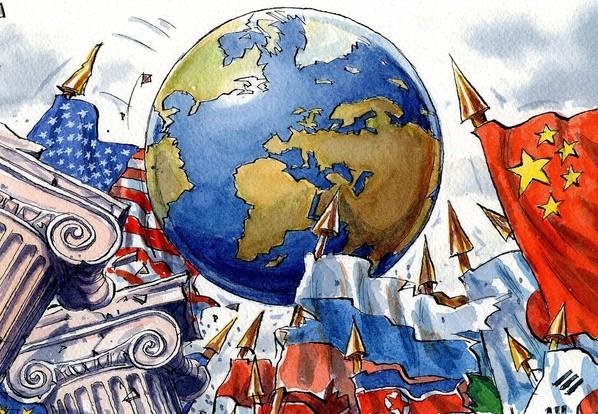By Charunivetha Solai Gnanasekar
Abstract
This article explores the evolution of power dynamics in world politics, focusing on the use of International Relations theories to understand the concept of power. Tracing historical shifts in power from Ancient Greece to the Cold War, it attempts to study the differences in the constituents of power over time. The diminishing use of force and military might and the growing influence of ideology, as seen during the Cold War, presents a question to be answered using theories. Mainstream theories in international relations fall short in elucidating the process underlying changing power dynamics, while the power transition theory offers a fresh perspective to comprehend the concept of power. The case study of China challenging the United States exemplifies the theory’s applicability in analysing geopolitical dynamics and ensuring international stability amidst evolving power paradigms.
Introduction:
Much of the debates surrounding issues on events in world politics revolve around the ability of a nation to influence another. That is how Robert Dahl, a leading political scientist, defines power in ‘The Concept of Power’: “A has power over B to the extent that he can get B to do something that B would not otherwise do”. But what guarantees power? Over the years, there has been a shift in the possession and display of power in world politics. The ‘Power Transition Theory’ is an International Relations theory that seeks to examine differential growth rates and their effect on altering relative power between nations. It provides a different lens through which one can examine not only the mechanisms driving power transitions but also their profound implications for international stability, cooperation, and order. This article delves into the historical shifts in power dynamics over time and emphasises the significance of the Power Transition Theory in understanding these changes. It illustrates how this theory complements mainstream International Relations Theories by addressing gaps in explaining power transitions between nations.
Historical Context:
The first landmark case of power transition happened during the Pelopponesian war between Athens and Sparta in 431 BC, a favoured illustration among realists to elucidate the world’s anarchic state and the pursuit of power. The conflict unfolded in two distinct phases spanning 10 and 11 years, respectively, interspersed by a six-year truce. Around the same time China witnessed its ‘Spring and Autumn Period’ (771-476 BCE), during which five hegemonic powers alternated in establishing order among numerous dispersed and fragmented Chinese enfeoffed states. This was again followed by the ‘Warring Period’ where seven major powers contended for supremacy from 475-221 BCE. Likewise, Europe underwent a series of rise and fall of empires since the 1500s, exemplified by the Portuguese Empire, Dutch Empire, British Empire, among others, asserting colonial dominion in various regions. A common thread linking these power transitions in the pre-World War period was their reliance on force. While a clash in ideology was a driving force in the conflicts, ideology itself was never used as a weapon.
As World War I unfolded, eight major powers, including Austria, France, Germany, Great Britain, Italy, Japan, Russia, and the United States, vied for supremacy. With the removal of Austria, Germany, and Russia from the equation, and the United States witnessing a zenith in its military capabilities during the conflict, the prospects for American hegemony appeared promising. However, the situation grew increasingly complex at this stage. Despite the fervour of the US President, Woodrow Wilson, to spearhead global leadership, as evidenced by his renowned “Fourteen Points” plan aimed at forging a new world order, and notwithstanding the nation’s formidable military influence, the European powers did not readily embrace America’s agenda. The absence of a clear hegemon or superpower precipitated a renewed struggle for power among the great powers, ultimately culminating in World War II.
The end of World War II resulted in the shift in power from the hands of mostly European states to two non-european states – USA and Russia, resulting in a bi-polar world. The Cold War marked the beginning of a new medium for the struggle for power. Countries no longer fought directly. They exerted their dominance by influencing other countries, spreading propaganda and ensuring that their ideology triumphs.
These historical examples, spanning ancient empires to modern superpowers, illustrate the recurring pattern of power transitions throughout world history. From the coercive dominance of military might in ancient times to the ideological struggles of the Cold War era, the mechanisms driving these shifts have evolved. Yet, the fundamental dynamic of rising powers challenging established hegemons remains a constant thread. Understanding the historical context of past power transitions provides valuable insights into the cyclical nature of such geopolitical shifts, setting the stage for examining contemporary theories that aim to explain and analyse these complex phenomena.
Contemporary Changes in Power Transition:
Historian A. J. P. Taylor said, “the test of a Great Power is the test of strength of war”. Modelski concedes that a great power “must be capable of fighting a major war”. Hence, military might was a defining feature of power. Following the historical context laid out in the previous section, we can deduce that the Cold War was a turning point in defining what constituted power. Scholars observe a general shift in the sources of power towards economic growth, education, and technology, with traditional determinants such as resources, population, and territory assuming an increasingly diminished role. In his book, The Theory of International Relations, Kenneth N. Waltz argues that a 5% growth rate sustained for three years would benefit the United States more than an alliance with Britain would.
One of the reasons for this shift away from military might as a source of power could be its diminishing cost effectiveness. Richard N. Rosecran says that in the past, “it was cheaper to seize another state’s territory by force than to develop the sophisticated economic and trading apparatus needed to derive benefit from commercial exchange with it”. This is not to disregard the realist school of thought in International Relations, as military might will invariably retain significance given the anarchic nature of world politics. However, there seems to be a growing apprehension to exercise military power and resort to force, which is augmented by the fear of nuclear escalation.
Another potent instrument of power that has grown to be of utmost importance is ideology – the primary weapon wielded by the USA and the Soviet Union during the Cold War. Pax Britannica and Pax Americana were successful because they were broadly accepted and welcomed. The dissemination of ideology can be construed as the final piece of the puzzle; a state may possess formidable military might, lay claim to territory, and command abundant resources, but without the endorsement of the populace, its prospects are destined for failure. As current trends emphasise economic development, education, and ideology over conventional military strength, grasping these shifts becomes essential for analysing international relations theories regarding changes in power dynamics.
Power in Mainstream International Relations Theories:
For a concept that permeates the disciple of International Relations as a whole, power is an understudied and poorly understood concept in International Relations and Political Science. While Robert Dahl’s definition, as stated in the introduction, is the most cited definition of power, most scholars cite it for critical purposes. The mainstream IR theories, while explaining the reasoning behind the desire for power and the consequences of the different power structures, scarcely explain how power is transferred from one state to another.
For example, realism takes the view that the anarchic state of the international system, forces states to strive for power. It places an emphasis on military might, rejecting the notion that wealth can serve as a substitute. On the other hand, a liberalistj perspective on power adopts an institutional approach, diverging from the pessimism of realism by contending that the anarchical state does not constantly compel states to be in a state of readiness. Instead, it asserts that power, when wielded through institutions, garners greater acceptance.
Constructivism focuses on power through ideology and norms. In International Norm Dynamics and Political Change, Finnemore and Sikkink note, “Norms held by states widely viewed as successful and desirable models are. . . likely to become prominent and diffuse”. To illustrate, the Cold War would be favoured by a constructivist to explain how the shift in power would function.
Power Transition Theory:
The Power Transition Theory, confounded by A. F. K. Organski, lays its central claims in the concept of a hierarchical system of power, with a dominant power at the top that creates and sustains the international order, and that new powers are constantly rising, owing to uneven growth rates. Further, it states that the risk of war is highest when a rising power is about to take over the dominant power.
While realism treats the state as a unitary actor, the power transition theory treats the rising powers as a collection of states dissatisfied with the order imposed by the dominant power. This dissatisfaction stems from the assumption that the dominant power and the rising powers have incompatible goals and that the order imposed by the dominant power will not favour the rising powers. As the rising power achieves parity with the dominant power, the likeliness of a war increases.
A contemporary example can be the rising power of China and the challenge that it poses on the power of the United States. According to the Power Transition Theory, China would form alliances to challenge the US’s power. This is seen in the formation of BRICS, and their aim for de-dollarisation. Through collective economic influence, BRICS tries to challenge the power of the USA, going against the realist power technique of using military might and self-reliance.
Conclusion:
The evolution of power dynamics in world politics has traversed through epochs, from the coercive hegemonies of ancient empires to the ideological battlegrounds of the Cold War and beyond. While mainstream International Relations theories suggest structures to study the desire for power, they fail to address the process of shift in power. Meanwhile, the Power Transition Theory fills this gap by providing a framework to understand how power transitions occur between dominant and rising powers, elucidating the risks of conflict during such transitions. As evidenced by contemporary examples like the rise of China challenging US hegemony, the theory remains relevant in analysing geopolitical dynamics. In an era where military might is complemented by economic influence and ideological persuasion, comprehending power transitions becomes paramount for navigating the complexities of global politics and ensuring international stability.
Author’s Bio
Charunivetha Solai Gnanasekar is a first year undergraduate student at the Jindal Global Law School with a keen interest in International Relations. Her interests in research lie in theoretical international relations and international law.
Image Source: https://chanakyaforum.com/the-future-of-us-super-power-status-post-covid/

